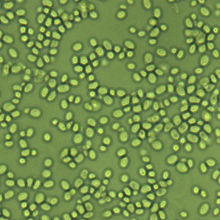Nakaseomyces glabratus
| Candida glabrata | |
|---|---|

| |
| Scientific classification | |
| Kingdom: | |
| Phylum: | |
| Subphylum: | |
| Class: | |
| Order: | |
| Family: | |
| Genus: | |
| Species: | C. glabrata
|
| Binomial name | |
| Candida glabrata (Anderson) Meyer & Yarrow
| |
| Synonyms | |
|
Torulopsis glabrata | |
Candida glabrata is a haploid yeast of the genus Candida, previously known as Torulopsis glabrata. This species of yeast is non-dimorphic and there has been no observed mating activity. Until recently, C. glabrata was thought to be a primarily non-pathogenic organism. However, with the ever increasing population of immunocompromised individuals, trends have shown C. glabrata to be a highly opportunistic pathogen of the urogenital tract, and of the bloodstream (Candidemia). It is especially prevalent in HIV positive people, and the elderly.
There are two widely cited potential virulence factors that contribute to the pathogenicity of C. glabrata. The first is a series of adhesins coded by the EPA (epithelial adhesin) genes. These genes, located in the subtelomeric region, can respond to environmental cues that allow them to be expressed en masse so the organism can adhere to biotic and abiotic surfaces in microbial mats. This is also the suspected mechanism by which C. glabrata forms microbial "biofilms" on urinary catheters, and less commonly in-dwelling IV catheters. It also causes problems with dental devices, such as dentures.
A major pheonotype and potential virulence factor that C. glabrata possesses is low-level intrinsic resistance to the azole drugs, which are the most commonly prescribed antifungal (antimycotic) drugs. These drugs, including fluconazole and ketoconazole, are quite useless against C. glabrata. While some have said that the organism possesses an "innate" immunity to the drugs, it is more accurate to say that the organism possesses an evolved resistance to the drugs. It is still highly vulnerable to polyene drugs such as amphotericin B and nystatin, along with variable vulnerability to flucytosine and caspofungin.
References
- Sobel et al. Candida glabrata: Review of Epidemiology, Pathogenesis, and Clinical Disease with Comparison to C. albicans. [1]
